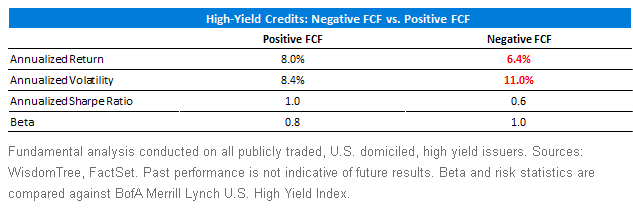Risk mitigation has been an increasing focus for our clients in managing their fixed income portfolios. Not coincidentally, it also lies at the core of our research into the development of
fundamentally weighted fixed income Indexes. Nowhere is this more relevant than when investing in more speculative
credits. Focusing on fundamentals, particularly today, should be of extreme importance to investors when considering allocations to the
high-yield market. Constructing a portfolio through a
market capitalization-weighted approach, or, to put it another way, agreeing to lend a risky borrower more money simply because they have issued more debt, lacks investment intuition, in our view. In order to combat this shortcoming, we sought to create Indexes that screen by fundamentals and tilt toward income.
For the high-yield investor, the greatest risk is that a company falls into distress and ultimately
defaults. As a result, the focus of our fundamental research was to understand ways to mitigate this risk. Our intuition and initial research pointed us to the importance of
cash flows. If you think about it, a large majority of companies in distressed situations often got there because of cash flow problems. Companies with inadequate or negative free cash flow (FCF) find themselves constantly under pressure to find the necessary resources to service their debts on time. If a leveraged business does not generate sufficient cash flow, its only other option may be to tap short-term
revolvers, raise additional debt or equity, or generate cash via asset sales. With only a limited set of options, companies with sustained negative trends in cash flow may eventually become insolvent.
To study the efficacy of cash flow and other fundamental factors for high yield, we screened the universe of all publicly listed, U.S.-domiciled issuers of high-yield debt that were downgraded by the major
ratings agencies between 2006 and 2016. The timeliness and accessibility of audited financials and market information for the credits gave the analysis breadth and depth.
While our
investment-grade strategy relies on
ranking companies by their fundamentals into five quintiles, our approach to high yield is even more direct. If an issuer has had positive FCF, on average, over the previous five years, it is eligible for inclusion in our Index
1. If cash flows turn negative, on average, over a rolling five-year period, that issuer is excluded from the Index. Below, we summarize the impact that focusing on FCF can have on a portfolio of high-yield corporate bonds.
Risk Statistics [May 31, 2006 – March 31, 2016]

Per the above table, high-yield issuers with positive FCF boosted total returns by 160
basis points (bps) per year while also reducing
volatility by 260 bps per year compared to issuers with negative FCF. In our view, this provided a meaningful increase in risk-adjusted returns for a notoriously volatile segment of the bond market. While enhancing risk-adjusted returns is beneficial, we also understand that many investors ultimately invest in high-yield bonds for income. In most instances, quality can often result in a sacrifice in yield. In step two of
our Index construction process, we seek to add back “quality” risk to the portfolio by tilting the final weights of securities in the portfolio toward income.
Ultimately, we believe that fundamentals are important when making investment decisions. While focusing on fundamentals is no guarantee of positive returns, blindly investing in the debt of the most indebted, risky borrowers seems ill-advised. Through our research, we believe that by focusing on free cash flow, investors could create a more intuitive approach to high-yield corporate credit.
1WisdomTree Fundamental U.S. High Yield Corporate Bond Index.
Important Risks Related to this Article
Fixed income investments are subject to interest rate risk; their value will normally decline as interest rates rise. In addition, when interest rates fall, income may decline. Fixed income investments are also subject to credit risk, the risk that the issuer of a bond will fail to pay interest and principal in a timely manner or that negative perceptions of the issuer’s ability to make such payments will cause the price of that bond to decline.


 Per the above table, high-yield issuers with positive FCF boosted total returns by 160 basis points (bps) per year while also reducing volatility by 260 bps per year compared to issuers with negative FCF. In our view, this provided a meaningful increase in risk-adjusted returns for a notoriously volatile segment of the bond market. While enhancing risk-adjusted returns is beneficial, we also understand that many investors ultimately invest in high-yield bonds for income. In most instances, quality can often result in a sacrifice in yield. In step two of our Index construction process, we seek to add back “quality” risk to the portfolio by tilting the final weights of securities in the portfolio toward income.
Ultimately, we believe that fundamentals are important when making investment decisions. While focusing on fundamentals is no guarantee of positive returns, blindly investing in the debt of the most indebted, risky borrowers seems ill-advised. Through our research, we believe that by focusing on free cash flow, investors could create a more intuitive approach to high-yield corporate credit.
1WisdomTree Fundamental U.S. High Yield Corporate Bond Index.
Per the above table, high-yield issuers with positive FCF boosted total returns by 160 basis points (bps) per year while also reducing volatility by 260 bps per year compared to issuers with negative FCF. In our view, this provided a meaningful increase in risk-adjusted returns for a notoriously volatile segment of the bond market. While enhancing risk-adjusted returns is beneficial, we also understand that many investors ultimately invest in high-yield bonds for income. In most instances, quality can often result in a sacrifice in yield. In step two of our Index construction process, we seek to add back “quality” risk to the portfolio by tilting the final weights of securities in the portfolio toward income.
Ultimately, we believe that fundamentals are important when making investment decisions. While focusing on fundamentals is no guarantee of positive returns, blindly investing in the debt of the most indebted, risky borrowers seems ill-advised. Through our research, we believe that by focusing on free cash flow, investors could create a more intuitive approach to high-yield corporate credit.
1WisdomTree Fundamental U.S. High Yield Corporate Bond Index.


